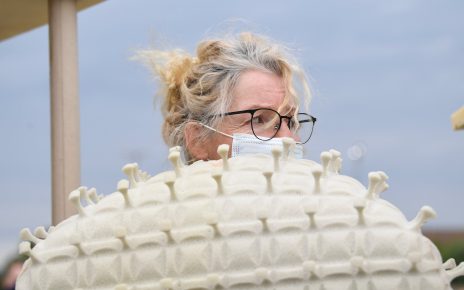Bats get a bad rap.
From horror films to tabloid pages to Halloween, media and cultural depictions of our planet’s only volant, or flying, mammals have long generated and reinforced unfounded fear. Their evident role as original source of the SARS-CoV-2 virus that produced the COVID-19 epidemic has exacerbated their unfortunate public image and even led to calls and active measures to cull or harass bat populations.
Such hostile attitudes make it harder to conserve bats and thereby safeguard the many critical benefits they provide us. What’s more, persecuting bats because of the diseases they harbor could easily backfire.
Before getting into that, let’s back up for a second.
THE TRUTH ABOUT BATS AND DISEASE
The kernel of truth regarding bats and disease is that the former do host an unusual variety of the latter, including viruses that can be deadly when they spill into the lives of other mammals like us. Other authors have thoughtfully covered the direct and indirect role bats played in the emergence of the likes of Ebola, Nipah and SARS. Rather than rehashing that here, we’ll just point out that recent research has suggested a reason why bats have been the source of an eyebrow-raising number of disease outbreaks. In short, the unique stress of flight may have supercharged bats’ ability to tolerate aggressive immune responses to certain pathogens, triggering the co-evolution of virulent viruses. The more pedestrian immune systems of earthbound mammals struggle to cope when those bad boy virions enter their system.
But before throwing bats out with the bathwater on the grounds of disease risk, we must consider the rich range of benefits they provide us, including several ways they keep us healthy. Bats help regenerate our forests and provide us with fertilizer. They pollinate our food plants, from mangos to agave, in total more than 300 species of crops. They also gobble up so many insect pests in fields of cacao, cotton, corn and countless other cultivated species that without them we’d see more than $3.7 billion per year in lost production in North America alone. These hungry mouths are particularly important in less economically developed countries, where a number of different species offer free-of-charge pest control services by feasting on multiple agricultural pests each.
Munching moths and other insects indirectly improves our health. The loss of bats following the spread of white-nose syndrome in the United States led to a measurable rise in infant morbidity and mortality in agricultural regions as toxic pesticide use rose to compensate for missing insectivores. Bats also eat disease-spreading nasties like mosquitoes, including the growing number of malaria-spreading Anopheles that have evolved resistance to insecticides.
Setting all that aside, culling or otherwise directly harming bats in an attempt to tamp down the risk of a future SARS or Ebola is based on faulty assumptions and may paradoxically lead to higher disease risk. Culling vampire bats to prevent rabies in Peru failed to contain the disease and may have disproportionately killed the bats that were least likely to spread the infection. In Uganda, an attempt to wipe out a large colony of Egyptian fruit bats led to a far higher incidence of Marburg virus when the site was recolonized by more susceptible individuals. Even stressing bats may lead to higher risk of disease transmission; such is the case with Hendra virus in Australian little red flying foxes.
In March, officials in Indonesia ordered the culling of captive bats in markets. There are rumors of officials in Rwanda blasting straw-colored fruit bat colonies with a firehose. These actions will have no impact on their stated purpose of helping address the current outbreak.
HOW DO WE PREVENT THE NEXT OUTBREAK?
We are still perfecting the recipe for heading off the next zoonotic pandemic. It certainly includes a heaping portion of enhanced disease surveillance and a healthy dollop of improved public health infrastructure. Less obvious though, is the mélange of ingredients united in their requirement that we stop treating bats as some sort of sinister “other.”
First, we need a range of targeted bat conservation efforts. Spillovers happen when we encroach into their world or drag them into ours. When inadequate forest resources led Pteropus fruit bats in Bangladesh to visit date palm trees, people unwittingly drank Nipah virus along with their customary raw date palm sap. More commonly, bat viruses hop into living stepping-stones including pigs (Nipah virus), horses (Hendra virus) or camels (MERS-related coronavirus). In their native habitats, bats are very unlikely to shed these viruses into dense concentrations of domesticated animals.
With their homes in good shape, there is less need for bats to spend time in ours. Large-scale habitat restoration could decrease problematic contact between bats and people or our domesticated animals, a side perk of global reforestation efforts. We may even be able to take targeted steps like establishing artificial bat roosts and native fruit trees in appropriate settings, reducing dangerous contact while still retaining the valuable services bats provide us. Building support for all these efforts, however, is vastly more difficult if we continue demonizing bats.
More empathy for bats could bolster efforts to limit or even outright end the wildlife trade, since it’s another common way in which bats are forced into direct or indirect contact with people. Indeed, a live-animal market in Wuhan was the apparent epicenter of the early weeks of the outbreak. The fact that bats may not have been sold there illustrates the need to crack down broadly against the commercial sale of nondomesticated creatures, given the diversity of animals that can be intermediary and amplifying hosts.
At the very least, we need commonsense constraints on the most dangerous practices (such as ending the trade of live wild animals; stopping the housing of large numbers of different species in close quarters; and preventing contact between captive animals and wild bats). Thankfully, China seems to be stepping up to the plate, but preventing a black market requires curbing demand for wildlife products, a task made that much easier by better bat public relations.
Staying safe also demands continued effort to illuminate the distribution, habitat associations and population trends of the lion’s share of the 1,400 recognized bat species, not to mention the diseases they harbor. Information is particularly limited in many of the most biodiverse areas of the planet, where new emerging infectious diseases are more likely to originate. Researchers struggle to fund expeditions to collect this basic natural history data when the public’s attitude to bats is more fear and loathing than respect and admiration.
Fortunately, we have some new tools at our disposal. Modern genome sequencing methods have begun prying open a window into the previously mysterious realm of bat viromes. Modern-day swashbuckling explorers are scaling cliffs in Madagascar and scouring caves in Sierra Leone to collect samples of all sorts of bodily fluids and solids from bats, sequencing the genetic material from the viruses contained within. Some are tracking how the risk of disease tracks with the seasons, reproductive cycles and climate, while others are dusting off clinical samples from patients that presented with high fever but went undiagnosed for known diseases. (Unfortunately, one of the key groups conducting this type of research recently had its funding cut by the current administration.)
Though we laud our colleagues’ efforts and attempt to walk the walk with our own research initiatives, it is also important to remember that the way we present our science matters too. Negative media representations of bats can arise directly from the framing of academic journal articles. We scientists must emphasize the good alongside the risk, and consistently drive home the message that it’s only by knowing, accepting and even celebrating bats that we can achieve the healthiest possible future.
Read more about the coronavirus outbreak from Scientific American here. And read coverage from our international network of magazines here.



